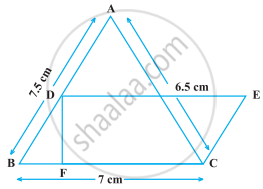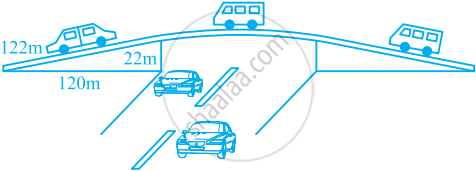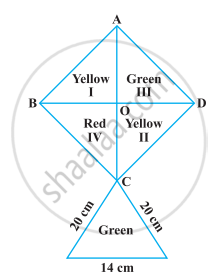Advertisements
Advertisements
Question
In the following figure, ∆ABC has sides AB = 7.5 cm, AC = 6.5 cm and BC = 7 cm. On base BC a parallelogram DBCE of same area as that of ∆ABC is constructed. Find the height DF of the parallelogram.

Solution
Now, first determine the area of ∆ABC.
The sides of a triangle are AB = a = 7.5 cm, BC = b = 7 cm and CA = c = 6.5 cm
Now, semi-perimeter of a triangle,
`s = (a + b + c)/2`
= `(7.5 + 7 + 6.5)/2`
= `21/2`
= 10.5 cm
∴ Area of ΔABC = `sqrt(s(s - a)(s - b)(s - c))` ...[By Heron’s formula]
= `sqrt(10.5(10.5 - 7.5)(10.5 - 7)(10.5 - 6.5))`
= `sqrt(10.5 xx 3 xx 3.5 xx 4)`
= `sqrt(441)`
= 21 cm2 ...(i)
Now, area of parallelogram BCED = Base × Height
= BC × DF
= 7 × DF ...(ii)
According to the question,
Area of ∆ABC = Area of parallelogram BCED
⇒ 21 = 7 × DF ...[From equations (i) and (ii)]
⇒ DF = `21/4` = 3 cm
Hence, the height of parallelogram is 3 cm.
APPEARS IN
RELATED QUESTIONS
The triangular side walls of a flyover have been used for advertisements. The sides of the walls are 122m, 22m, and 120m (see the given figure). The advertisements yield an earning of ₹ 5000 per m2 per year. A company hired one of its walls for 3 months. How much rent did it pay?

Find the area of a triangle two sides of which are 18 cm and 10 cm and the perimeter is 42 cm.
A triangle has sides 35 cm, 54 cm and 61 cm long. Find its area. Also, find the smallest of its altitudes ?
The perimeter of an isosceles triangle is 42 cm and its baše is (32) times each of the equal sides. Find the length of each side of the triangle, area of the triangle and the height of the triangle.
Find the area of the triangle formed by the points
(–10, –4), (–8, –1) and (–3, –5)
If (5, 7), (3, p) and (6, 6) are collinear, then the value of p is
Find the area of a triangle formed by the lines 3x + y – 2 = 0, 5x + 2y – 3 = 0 and 2x – y – 3 = 0
Using Heron’s formula, find the area of a triangle whose sides are 10 cm, 24 cm, 26 cm
A field in the form of a parallelogram has sides 60 m and 40 m and one of its diagonals is 80 m long. Find the area of the parallelogram.
How much paper of each shade is needed to make a kite given in the following figure, in which ABCD is a square with diagonal 44 cm.
